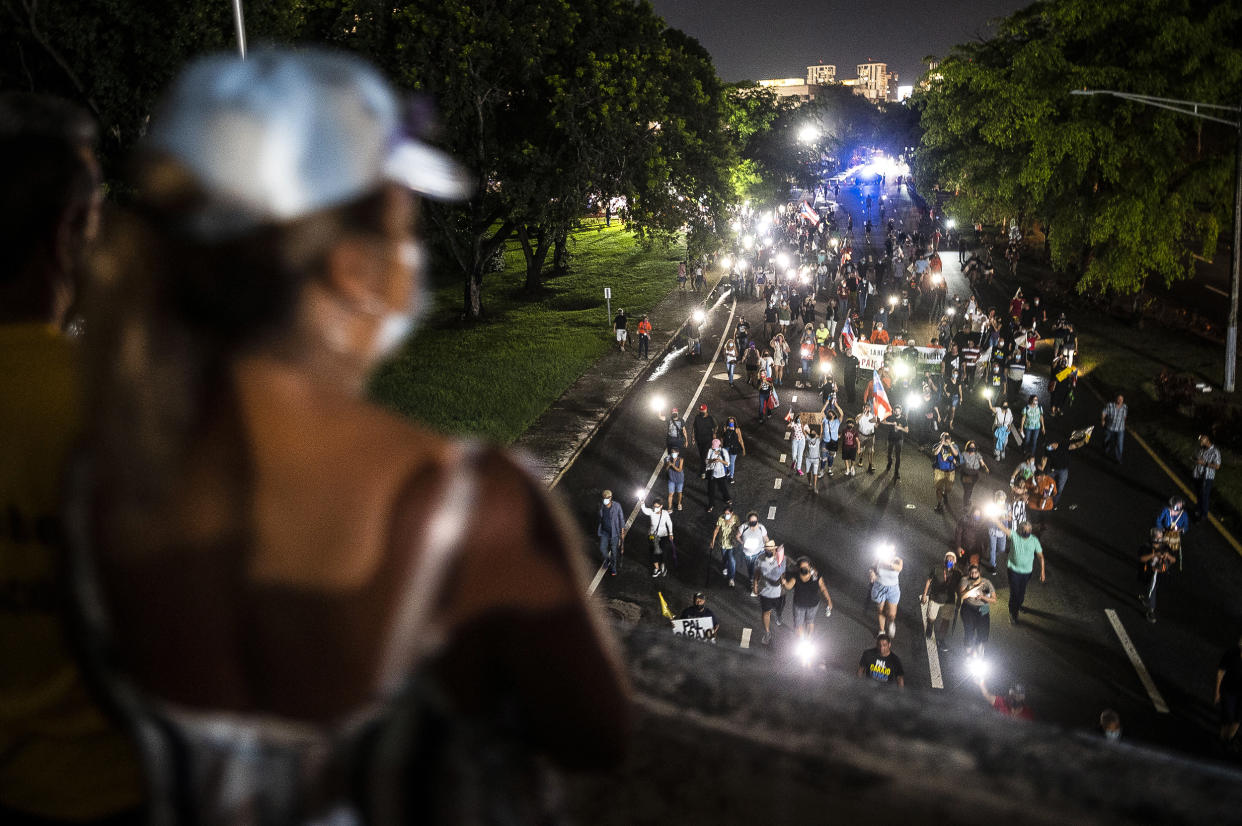Who's to blame for Puerto Rico's power crisis? It's complicated, a report shows
Ongoing power outages in Puerto Rico constantly remind residents that essential work to modernize their antiquated and unreliable electric grid, which was also decimated by Hurricane Maria in 2017, has not yet begun.
But officials hoped the partial privatization of the power grid, which started this summer, would help resolve the U.S. territory's power supply crisis.
Instead, Puerto Ricans like Brenda Otero, who owns a baking business in San Juan, have endured a growing number of rolling blackouts and unstable service.
"We don’t have any hurricane, and it’s worse now," Otero, whose business lost more than $1,000 as a result of the blackouts this month, said. "It’s getting harder to work and to pay off the bills."
That outrage spilled over the streets of Puerto Rico on Friday as more than 4,000 people marched down San Juan's main highway, blocking traffic, to protest the power outages and decry how the lack of electricity has deteriorated their quality of life.
The two entities in charge of providing electricity to Otero and 3.2 million Puerto Ricans have been pointing fingers at each other over who is responsible for the worsening power crisis. But a new analysis from the Center for a New Economy, a Puerto Rico-based nonpartisan think tank, showed they both share a fair portion of the blame.

Sergio Marxuach, CNE’s policy director and author of the analysis, said in a statement Thursday that "a decrepit generation fleet" as well as an unstable energy transmission and distribution grid are to blame for recent rolling blackouts alongside "a series of coordination failures" between the Puerto Rico Electric Power Authority and Luma Energy — which are responsible for the island's electricity.
How did Puerto Rico get here?
Marxuach started the report by taking a trip down memory lane: resurfacing records showing how the Puerto Rico Electric Power Authority, a public corporation, was forced to declare bankruptcy in May 2017 following years of low liquidity, limited access to capital markets and "funding current spending with long-term debt."
Additionally, the power authority contributed to the island’s decadeslong financial crisis by racking up $9 billion in public debt, more than that of any other government agency in Puerto Rico.
A combination of all these practices resulted in a significant reduction in grid maintenance expenditures and, in turn, deteriorated the power system's overall performance, according to the analysis. That deterioration was later exacerbated by Hurricane Maria, which triggered the world’s second-longest blackout in September 2017.
The patched-up grid will continue acting up until a thorough refurbishing of the grid takes place, an endeavor that could cost more than $10 billion and last decades, according to the power authority.
Against this backdrop, the Puerto Rican government reached an agreement with Luma Energy, a consortium owned by a private company in Canada and another one in Texas, as part of its efforts to privatize the power grid.
The private company took over Puerto Rico's transmission and distribution of electricity in June as the power authority remained in charge of controlling power generation units.
Luma Energy CEO Wayne Stensby told NBC News this month he's confident that Puerto Rico's power crisis “will get better month by month and year by year.”
“The single biggest challenge is the speed in which we can actually bring real improvements to our customers,” Stensby said.
But since the company started working in Puerto Rico, residents have experienced longer service restoration times, poor customer service and voltage fluctuations that often damage appliances and other home electronics, according to an analysis from the Institute for Energy Economics and Financial Analysis, a nonprofit group that conducts research and analyses on financial and economic issues related to energy and the environment.
In his analysis, Marxuach pointed out that Luma Energy had about a year to prepare before its takeover, "and its performance so far has been, in the best case, deficient, and in the worst, dismal."
"Its management, so far, has utterly failed to deliver on its promises," Marxuach added.
'In the best interests of both companies to change their ways'
Under the current partnership, the power authority is "required to provide 'dependable generation capacity' in exchange for a monthly payment from LUMA to cover operating and maintenance expenses," the analysis said. The private company also has "absolute control to dispatch generation and manage system load at any given time," according to the report.
But power customers in Puerto Rico are the ones paying the price over a complicated arrangement that "requires good faith efforts from both companies to run the system successfully," Marxuach wrote.
"It is in the best interests of both companies to change their ways, for their own benefit and the wellbeing of the Puerto Rican people," the analysis concluded.
In it, Marxuach urged the power authority to stop "clinging to its old ways" and called on Luma Energy to "modify its standard playbook to account for an old, unstable, and unreliable electric system."
Follow NBC Latino on Facebook, Twitter and Instagram.
